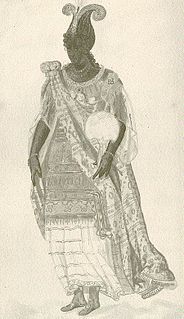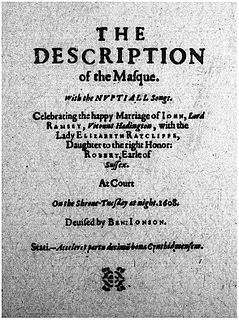Related Research Articles

The Masque of Blackness was an early Jacobean era masque, first performed at the Stuart Court in the Banqueting Hall of Whitehall Palace on Twelfth Night, 6 January 1605. It was written by Ben Jonson at the request of Anne of Denmark, the queen consort of King James I, who wished the masquers to be disguised as Africans. Anne was one of the performers in the masque along with her court ladies, all of whom appeared in blackface makeup.
The Staple of News is an early Caroline era play, a satire by Ben Jonson. The play was first performed in late 1625 by the King's Men at the Blackfriars Theatre, and first published in 1631.
Love's Welcome at Bolsover is the final masque composed by Ben Jonson. It was performed on 30 July 1634, three years before the poet's death, and published in 1641.
Love's Triumph Through Callipolis was the first masque performed at the Stuart Court during the reign of King Charles I, and the first in which a reigning monarch appeared. The work was written by Ben Jonson, with costumes, sets, and stage effects designed by Inigo Jones, and music by Nicholas Lanier. This play Also played in Greece national theatre in 1979 together with the Johnsons masques Oberon, the faery prince and News from the new world discovered in the moon.
Chloridia: Rites to Chloris and Her Nymphs was the final masque that Ben Jonson wrote for the Stuart Court. It was performed at Shrovetide, 22 February 1631, with costumes, sets and stage effects designed by Inigo Jones.
Oberon, the Faery Prince was a masque written by Ben Jonson, with costumes, sets and stage effects designed by Inigo Jones, and music by Alfonso Ferrabosco and Robert Johnson. Oberon saw the introduction to English Renaissance theatre of scenic techniques that became standard for dramatic productions through the coming centuries.
Love Restored was a Jacobean era masque, written by Ben Jonson; it was performed on Twelfth Night, 6 January 1612, and first published in 1616. The Dictionary of National Biography says of the masque, "This vindication of love from wealth is a defense of the court revels against the strictures of the puritan city."

The Hue and Cry After Cupid, or A Hue and Cry After Cupid, also Lord Haddington's Masque or The Masque at Lord Haddington's Marriage, or even The Masque With the Nuptial Songs at the Lord Viscount Haddington's Marriage at Court, was a masque performed on Shrove Tuesday night, 9 February 1608, in the Banqueting House at Whitehall Palace. The work was written by Ben Jonson, with costumes, sets, and stage effects designed by Inigo Jones, and with music by Alfonso Ferrabosco – the team of creators responsible for previous and subsequent masques for the Stuart Court.
The Golden Age Restored was a Jacobean era masque, written by Ben Jonson and designed by Inigo Jones; it was performed on 1 January and 6 January 1616, almost certainly at Whitehall Palace.
Mercury Vindicated from the Alchemists at Court is a Jacobean-era masque, written by Ben Jonson and designed by Inigo Jones. It was performed at Whitehall Palace on Twelfth Night, 6 January 1615. King James I liked it so much that he ordered a repeat performance the following Sunday, 8 January.
Neptune's Triumph for the Return of Albion was a Jacobean era masque, written by Ben Jonson, and designed by Inigo Jones. The masque is notable for the contradictory historical evidence connected with it and the confusion it caused among generations of scholars and critics.
The Coronation Triumph is a Jacobean era literary work, usually classed as an "entertainment," written by Ben Jonson for the coronation of King James I and performed on 15 March 1604. Jonson's work was half of a total performance, the other half written by Thomas Dekker. The work was especially significant in the developing literary career of Jonson, in that it marked the commencement of his role as a writer of masques and entertainments for the Stuart Court, a role he would fill for the next three decades.
The Entertainment at Althorp, or The Althorp Entertainment, performed on 25 June 1603 is an early Jacobean era literary work, written by Ben Jonson. It is also known by the alternative title The Satyr. The work marked a major development in Jonson's career, as the first of many entertainments and masques that he would write for the Stuart Court.
Pleasure Reconciled to Virtue is a Jacobean era masque, written by Ben Jonson and designed by Inigo Jones. It was first performed on Twelfth Night, 6 January 1618, in the Banqueting House at Whitehall Palace. The work's failure on its initial performance, and its subsequent revision, marked a significant development in Jonson's evolving masque technique.
The Memorable Masque of the Middle Temple and Lincoln's Inn was a Jacobean era masque, written by George Chapman, and with costumes, sets, and stage effects designed by Inigo Jones. It was performed in the Great Hall of Whitehall Palace on 15 February 1613, as one item in the elaborate festivities surrounding the marriage of Princess Elizabeth, daughter of King James I, to Frederick V, Elector Palatine in the Rhineland.
The Masque of Augurs was a Jacobean era masque, written by Ben Jonson and designed by Inigo Jones. It was performed, most likely, on Twelfth Night, 6 January 1622.
The Weeding of the Covent Garden, or the Middlesex Justice of Peace, alternatively titled The Covent Garden Weeded, is a Caroline era stage play, a comedy written by Richard Brome that was first published in 1659. The play is a noteworthy satire on the emerging ethos of Capitalism as reflected in real estate and urban development in the early modern city.
Time Vindicated to Himself and to his Honours was a late Jacobean era masque, written by Ben Jonson and with costumes, sets, and stage effects designed by Inigo Jones. James's son and heir Prince Charles led the dances of the principal masquers, as he had in several previous masques at the Stuart Court.
Luminalia or The Festival of Light was a late Caroline era masque or "operatic show", with an English libretto by Sir William Davenant, designs by Inigo Jones, and music by composer Nicholas Lanier. Performed by Queen Henrietta Maria and her ladies in waiting on Shrove Tuesday, 6 February 1638, it was one of the last and most spectacular of the masques staged at the Stuart Court.
Lovers Made Men, alternatively titled The Masque of Lethe or The Masque at Lord Hay's, was a Jacobean era masque, written by Ben Jonson, designed by Inigo Jones, and with music composed by Nicholas Lanier. It was performed on Saturday 22 February 1617, and was significant in the development and acceptance of opera in seventeenth-century England.
References
- Leapman, Michael. Inigo: The Troubled Life of Inigo Jones, Architect of the English Renaissance. London, Headline Book Publishing, 2003.
- Orgel, Stephen, ed. Ben Jonson: Complete Masques. New Haven, Yale University Press, 1969.
- Schuchard, Marsha Keith. Restoring the Temple of Vision: Cabalistic Freemasonry and the Stuart Culture. Boston, Brill Academic Publishers, 2002.